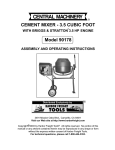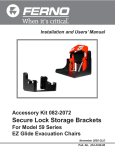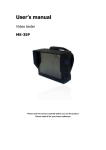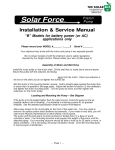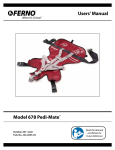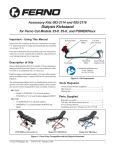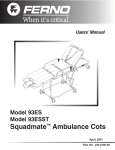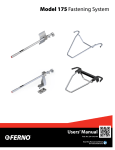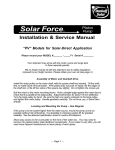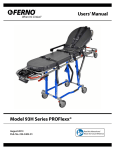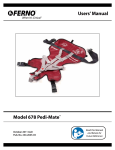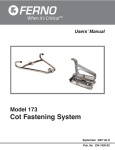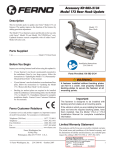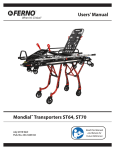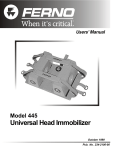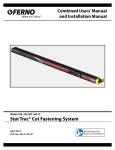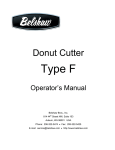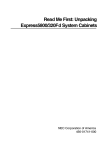Download Bariatric Boards LBS - 081-9991, 082-2057 LBS Jr. - 082
Transcript
LBS and LBS Jr. Bariatric Boards Kit 081-9991 or 082-2057 LBS Bariatric Boards LBS - 081-9991, 082-2057 LBS Jr. - 082-1936, 082-2184 Kits 082-1936 or 082-2184 LBS Jr. Description ● Kit 081-9991 includes one LBS (Large Body Surface) bariatric board and mounting hardware to attach it to a Ferno® 93H PROFlexx®, 35P PROFlexx® or 93P PROFlexx® cot. ● Kit 082-2057 includes one LBS bariatric board and mounting hardware to attach it to a Ferno® 35X PROFlexx® or POWERFlexx® + cot. ● Kit 082-1936 LBS Jr. bariatric board and the mounting hardware to attach it to a Ferno® 93H PROFlexx®, 35P PROFlexx® or 93P PROFlexx® cot. ● Kit 082-2184 include one LBS Jr. bariatric board and the mounting hardware to attach it to a Ferno® 35X PROFlexx® or POWERFlexx® + cot. When used with a Ferno® cot, the bariatric board provide a wider patient surface, additional handholds, and restraint extenders to aid in transporting a very large patient. The LBS offers the maximum patient surface possible while allowing the cot to use a standard (36"/914.4 mm) doorway, while the LBS Jr. includes two adjustable side “wings” that can be locked in a raised position for patient security or laid flat to provide additional patient surface. An LBS with a serial number later than JJ 267898 is compatible with Ferno’s 513-LBS IV pole (see Ferno® Customer Relations, page 16). A pillow wedge is included with each kit to provide comfort for the patient’s lower back and fill the gap between the bariatric board and the cot backrest. Ferno’s Model 132 Manta Rescue Aid is provided with each kit to assist moving a patient onto the cot. Parts and Tools Supplied 1 ea 4 ea 1 ea 1 ea 2 ea 2 ea 1 ea 1 ea 1 ea LBS (Large Body Surface) or LBS Jr. Mounting Block Pillow Wedge Restraint Extender (1'/304.8 mm) Restraint Extender (2'/609.6 mm) Adjustable Restraint Extender (3'/914.4 mm) 417-1 Lap Belt Model 132 Manta Rescue Aid 3/16" Allen Wrench © Ferno-Washington, Inc 234-3537-00 July 2013 Important Attaching the bariatric board to a cot does not increase the cot’s load limit. Include the weight of the bariatric board, the patient, and any other attached equipment when calculating the total load on the cot. Use additional help when lifting heavy loads. Follow approved bariatric transport procedures if exceeding the cot’s Standard Load Limit. Inspect the cot if the load limit has been exceeded. 1 LBS and LBS Jr. Bariatric Boards Specifications Cot Fastening System Compatibility Compatible Cots The bariatric board is designed for use in an ambulance with a center-mounted cot fastening system (Ferno® Model 175 antler-and-rail fastener or Ferno® Stat Trac fastener). Cot fastening systems attached near or on the ambulance side wall do not offer sufficient space for the cot to be secured while the bariatric board is attached. 081-9991 LBS and 082-1936 LBS Jr. (Uses Low Mounting Blocks) The LBS Jr. can be secured in a floor-mounted cot fastening system that is mounted near a wall only when the wings are locked in the raised position. 082-2057 LBS and 082-2184 LBS Jr. (Uses High Mounting blocks - PWR Stamped on Mount) The floor-mounted fastening system must be mounted away from the side wall. Refer to the cot fastening system installation manual for instructions on finding the centerline. ● LBS: The floor-mounted fastening system must be mounted a minimum of 18"/457.2 mm away from the wall of the ambulance. ● LBS Jr. (wings extended): The floor-mounted fastening system must be mounted a minimum of 21.5"/546.1 mm away from the wall of the ambulance. ● LBS Jr. (wings folded): The floor-mounted fastening system must be mounted a minimum of 14.5"/368.3 mm away from the wall of the ambulance. ● For use with Model 93H PROFlexx® Series ● For use with Model 35P PROFlexx® Series ● For use with Model 93P PROFlexx® Series ● For use with Model 35X PROFlexx® Series ● For use with POWERFlexx® + Important Earlier versions of the LBS may have location mounts for six blocks. Only four blocks are necessary; use the four outside mounts and disregard the two middle mounts. General Specifications LBS Length Width Open Thickness Open Width Folded Thickness Folded Weight* 54-1/4 " (1380 mm) 33-3/4" (860 mm) 2" (50 mm) 17" (430 mm) 4-1/4" (110 mm) 25 lbs (11 kg) LBS Jr. Open Dimensions Length Width (Wings Raised) Width (Wings Extended) Thickness Folded Dimensions Length Width Thickness Weight* 43" (1090 mm) 29" (740 mm) 41" (1040 mm) 3" (70 mm) 43" (1090 mm) 29" (740 mm) 5" (130 mm) 27 lbs (12 kg) * Weight includes the bariatric board, all mounting hardware, and the pillow wedge 2 © Ferno-Washington, Inc 234-3537-00 July 2013 LBS and LBS Jr. Bariatric Boards Components or LBS Jr. Underside View LBS Underside View Model 132 Manta Rescue Aid Pillow Wedge 3/16" Allen Wrench Bottom View of Mounting Block Low Mounting Block for kits 081-9991 or 082-1936 (4) High Mounting Block (with PWR mark on bottom) for kits 082-2057 or 082-2184 (4) Restraint Extenders and Lap Belt © Ferno-Washington, Inc 234-3537-00 July 2013 3 LBS and LBS Jr. Bariatric Boards First-Time Setup Prepare the Cot Before attaching the bariatric board, prepare the cot as follows (see the cot and accessory users’ manuals for detailed instructions): ● Place the cot in a rolling position ● Extend the drop frame ● Lower the shock frame ● Completely lower the sidearms ● Remove the cot mattress; it is not used when the bariatric board is attached ● Remove any cot-mounted accessories such as IV poles, Pac Rac instrument tray, Oxy-Clip, etc. (Figure 1). Exceptions: You do not need to remove an oxygen bottle holder that is mounted to the foot end of the cot or to the reverse side of the backrest. ● Completely raise the backrest (Figure 2) Figure 1 - Cot Prepared For Use With the LBS Important Keep the matching halves of each mounting block grouped together after separating them (step 5 below). Do not mix the mounting block tops and bottoms. Figure 2 - Cot Prepared For Attaching the Bariatric Board Prepare the Mounting Blocks 1. Verify you have the correct mounting block (see Components, page 3): ○○ Model 35X or POWERFlexx cots must use the mounting blocks with “PWR” stamped on the bottom of the block. ○○ Model 35P or 93P cots must use mounting blocks without a stamp on the bottom of the block. 2. Open (unfold) the bariatric board and lay it on a flat surface with its underside facing up. 3. Remove the mounting pin from each of the four mounting points (Figure 3). Figure 3 - Remove Pins From Mounting Points 4. Use the 3/16" Allen wrench provided to remove the two socket-head cap screws from each mounting block (Figure 4). Important Keep the matched halves of each mounting block together. Do not mix the mounting block tops and bottoms. 5. Separate the mounting block halves, but keep the matched halves together - do not mix the mounting block tops and bottoms. 4 Figure 4 - Removing Screws from the Mounting Blocks © Ferno-Washington, Inc 234-3537-00 July 2013 LBS and LBS Jr. Bariatric Boards Attach the Top Half Mounting Blocks 1. Attach the top half of a mounting block to a mounting point on the bottom of the bariatric board by aligning the holes in the mounting block with the holes in the mounting point, then inserting the pin through the aligned holes (Figure 5) so that the pin is inserted towards the center of the bariatric board. Insert towards the center of the bariatric board Figure 5 - Attaching the Top Half of a Mounting Block 2. Repeat Step 1 to secure the remaining three mounting blocks in the mounting points (Figure 6). 3. Turn the bariatric board right-side up, and proceed to Attach the Pillow Wedge, below. Figure 6 - Top Half Mounting Blocks in Place Warning Always use the pillow wedge supplied with the bariatric board. Failure to use the pillow wedge can cause the patient to be pinched as the backrest is raised. Attach the Pillow Wedge The pillow wedge provides comfort for the patient’s lower back by filling the gap between the bariatric board and the cot backrest. Figure 7 - Attaching the Pillow Wedge 1. Unfold the pillow wedge and place it fold-side up at the head-end of the bariatric board with the narrow edge facing the head-end of the cot. This placement will allow the pillow wedge to be folded when the bariatric board is folded. 2. Thread the hook-and-loop fastening straps through the pillow wedge slots in the bariatric board to secure the pillow wedge to the frame (Figure 7). © Ferno-Washington, Inc 234-3537-00 July 2013 5 LBS and LBS Jr. Bariatric Boards Attach the Bariatric Board to the Cot Attach the Bariatric Board Important Use a helper to attach the bariatric board to the cot. 1. Prior to attaching the LBS bariatric board to the cot, verify you have attached the correct mounting block to your bariatric board. Refer to Prepare the Mounting Blocks, page 4, and Attach the Mounting Blocks, page 5. 2. LBS: Place the LBS on the cot with its the armrests towards the head end (Figure 8). LBS Jr.: Place the LBS Jr. on the cot with the curved corners toward the foot end of the cot, and the pillow wedge on the backrest (Figure 9) Figure 8 - LBS Positioned on a Cot Important Verify all four mounting blocks are seated on the cot main frame (not on a cot casting or other structure). 3. After positioning the bariatric board on the cot, check the following: ○○ Raise the backrest completely, then slide the bariatric board as close to the backrest as possible. This will allow full use of the backrest when the bariatric board is attached. ○○ Verify that the bariatric board will not interfere with backrest operation. Important Keep the matched halves of each mounting block together. Do not mix the mounting block tops and bottoms. Figure 9 - LBS Jr. Positioned on a Cot 4. Adjust the position of the bariatric board if needed before continuing with the installation. 5. Use the 3/16" Allen wrench (provided) to attach two socket head cap screws and a lower-half mounting block to each top-half mounting block (Figure 10). Tighten screws evenly. After the bariatric board has been secured to the cot, the restraints can be installed. See Attaching and Using Restraints and Restraint Extenders, page 9. Figure 10 - Attaching the Lower Half of the Mounting Blocks 6 © Ferno-Washington, Inc 234-3537-00 July 2013 LBS and LBS Jr. Bariatric Boards Typical Use: Using the Bariatric Board With the Cot Attaching/Removing the Bariatric Board After the mounting blocks have been properly positioned and secured to the cot main frame, attaching and removing the bariatric board is quickly accomplished using the pins. Leave the mounting blocks installed on the cot at all times. They are lower than the patient surface when the cot mattress is attached, and will not interfere with normal cot use (Figure 11). To remove the bariatric board from the cot: Remove the four pins from the mounting blocks, and lift the bariatric board off the cot and set aside. Reinsert the pins in the mounting points beneath the bariatric board to keep them out of the way. Figure 11 - Mounting Blocks Installed on a Cot To attach the bariatric board to the cot: Remove the pins from the mounting points. Set the bariatric board on the cot with the mounting points over the mounting blocks (Figure 12). Insert the pins through the mounting blocks and mounting points (Figure 13). About the Cot Features Side Telescoping Handles The side telescoping handles can still be used under most circumstances. The operator or assistant using the side handle may wish to grasp the side handle with one hand and the bariatric board main frame with the other. If not used, retract the handles. Figure 12 - Attaching/Removing the Bariatric Board Shock Frame The shock frame cannot be used when the bariatric board is attached. Lead Handle The cot lead handle should not be used when transporting a very large patient. Instead, the operators and helpers should maintain a firm grasp on the cot main frame and the bariatric board main frame. If the cot will be used as a bariatric sled (rolled in the folded position), a set of push/pull handles can be attached (see Accessories and Replacement Parts, page 16). Figure 13 - Inserting the Pin Mattress The cot mattress is not used with the bariatric board. Remove it before placing the bariatric board on the cot. An accessory mattress for use with the bariatric board is available from Ferno® Customer Relations (see Accessories and Replacement Parts, page 16). © Ferno-Washington, Inc 234-3537-00 July 2013 7 LBS and LBS Jr. Bariatric Boards Backrest Use of the cot backrest is unaffected if the bariatric board is positioned properly (Figure 14). Raise and lower the backrest as instructed in the cot users’ manual. Follow your local medical protocols regarding when to place a patient in a raised position. If the bariatric board interferes with backrest operation, adjust its position. See Attach the Bariatric Board to the Cot, page 6. Warning Always use the pillow wedge supplied with the bariatric board. Failure to use the pillow wedge can cause the patient to be pinched as the backrest is raised. IV Pole The Ferno® Model 513-LBS pole mounts on the frame or mounting block of an LBS or LBS Jr. When mounted on a bariatric board, the pole mounts to a notch near the head end (Figure 15). The pole may be used with all LBS Jr. models but is only compatible with LBS boards with serial number JJ 267898 or higher. When the bariatric board is not in use, the pole can be mounted on one of the LBS mounting blocks attached to the cot. Figure 14 - Using the Backrest Warning Using an IV Pole other than a Model 513-10 IV pole in an MR (magnetic-resonance) environment can cause injury. NEVER take a Model 513-11, 513-13, 513-LBS, 513-EFX, or 513-EFX MB IV Pole into an MR environment. 513-LBS IV Pole Mounting Points Mounting Notch (2) for 513-LBS Pole The IV pole is available separately (see Accessories and Replacement Parts, page 16). Preparing to mount the pole 1. Compare your pole’s mounting block to the mounting block in Figure 16 to verify that you have the Model 513-LBS pole. 2. Select an appropriate mounting point from the mounting points indicated in Figure 15. Note: LBS Jr. Only: You may ONLY mount an IV pole at one of the two mounting notches near the foot end of the frame if not using the angled or straight bariatric push pull handle with the bariatric board (see Accessories and Replacement Parts, page 16). Mounting Notch (6) for 513-LBS Pole Figure 15 - Mounting Points for 513-LBS Pole Locking Pin Pole Adapter Mount Mounting Block (Top Half) Figure 16 - Model 513-LBS Pole Mounting Block 8 © Ferno-Washington, Inc 234-3537-00 July 2013 LBS and LBS Jr. Bariatric Boards Mounting the pole on a bariatric board 3. Pull the locking pin to disconnect the mounting block from the pole. 4. Use the 3/16" Allen wrench (supplied) to remove the two cap screws from the mounting block. 5. Position the top portion of the mounting block on the selected bariatric-board notch. Mounting Block 6. Align the bottom portion of the mounting block with the top portion and reattach the two cap screws. Verify that the mounting block is secure. 7. Fit the pole over the mounting block while aligning the holes in the pole with those on the block (Figure 17). Insert the locking pin through the aligned holes. Figure 17 - Mounting the Model 513-LBS Pole To remove the pole from the bariatric board for storage, pull the locking pin and lift the pole from the mounting block. To attach and use the Model 513-LBS pole on the cot, see page 20. Using the Wings (LBS Jr. Only) The side wings lock in a raised position for patient security. They can also be lowered level with the LBS Jr. surface to provide a larger patient surface, or lowered completely. To adjust, gently pull the control cable strung between the locking pins (Figure 18). Use the LBS Jr. only with both wings at the same position. Figure 18 - Adjusting the Wing Examples of the wings are shown in Figures 19 and 20. Attaching and Using Restraints and Restraint Extenders A Note About Restraints Warning Improper use of the restraints can cause injury. Attach patient restraints to the cot main frame only, not the bariatric board. Figure 19 - Wings Locked in the Raised Position Patient restrains must always be attached to the cot main frame, not to the bariatric board. The main frame is the strongest part of the cot. Follow the guidelines in the restraint and cot users’ manuals, with the following changes: 1. Discard the Model 417-1 lap-belt supplied with the cot, and to ensure compatibility with the restraint extenders provided, use only the Model 417-1 lap-belt provided (Figure 21, page 10) in this kit with your harness restraint at all times, even when the bariatric board is not attached to the cot. 2. When using the bariatric board, attach restraint extenders as needed to properly restrain the patient. © Ferno-Washington, Inc 234-3537-00 July 2013 Figure 20 - Wings Lowered in the Level Position 9 LBS and LBS Jr. Bariatric Boards Using the Lap Belt The extenders provide additional length for restraining and securing a large patient. Five restraint extenders are included with the bariatric board to accommodate variances in patient size (Figure 21). The 1-foot and 2-foot restraint extenders are not compatible with the Model 417-1 harness restraint. The 3-foot adjustable extenders are compatible with the harness as long as you use the new lap belt provided. To ensure your Model 4171 harness will function properly if the 3-foot extenders are required, always use the lap belt, even when the bariatric board is not on the cot. If the lap belt becomes frayed, worn, or cut, replace it with a like model (see Accessories and Replacement Parts, page 16). Routing the Lap Belt (LBS Jr. Only) When the bariatric board is placed on the cot, the model 4171 lap belt lies close to the head end of the bariatric board. Do not wrap the lap belt around the end of the bariatric board,as it could slide off and provide insufficient restraint for the patient. Instead, route the lap belt across the backrest frame only (Figure 22). This method will also provide more adjustment for the straps. Figure 21 - Restraint Extenders and Lap Belt Warning Failure to use the lap belt can allow belt failure and cause injury. Discard the black lap belt supplied with the cot, and always use the lap belt provided with the bariatric board. Replace the lap belt with a like model when replacement is needed. Do Not Route the Lap Belt Over the End of the Bariatric Board. Figure 22 - Lap Belt Placement on LBS Jr. 10 © Ferno-Washington, Inc 234-3537-00 July 2013 LBS and LBS Jr. Bariatric Boards Using Restraint Extenders The restraint extenders are compatible with all Ferno® Model 430 metal buckle restraints. When using the restraint extenders: 1. Verify that your existing lap and leg restraints are attached to the cot main frame, and the existing harness shoulder straps are attached to the backrest. 2. Attach the bariatric board to the cot. 3. Wrap the lap and leg restraints around the main frame of the bariatric board (Figure 24 and 25). Note: Route the restraints between the LBS Jr. patient surface and the wing release cable as shown in Figure 25. Do not route the restrains over the cable as this could lead to accidental activation of the cable. Figure 23 - Attach Cot Restraints to the Main Frame Using the New Lap Belt Figure 24 - Restraints Attached and Wrapped Around LBS Wing Release Cable Restraints Figure 25 - Restraints Attached and Wrapped Around LBS Jr. © Ferno-Washington, Inc 234-3537-00 July 2013 11 LBS and LBS Jr. Bariatric Boards 4. Connect restraint extenders to your existing cot restrains (except the 417-1 lap belt) to gain additional length for restraining and securing a large patient. Five restraint extenders are included to accommodate variances in patient size (see Components, page 3). Examples are shown in Figures 26 and 27. 3' Restraint Extender 5. If the shoulder harness restraint must be extended, use the two 3-foot extenders to keep the shoulder straps and links centered on the patient. Only the 3-foot extenders are compatible with the harness restraint buckle. 2' Restraint Extender See Accessories and Replacement Parts, page 16, for additional cot restraints and extenders. 1' Restraint Extender Figure 26 - Example of Restraint Extenders on LBS New 417-1 Lap Belt Strap 2' Restraint Extender 1' Restraint Extender Figure 27 - Example of Restraint Extenders on LBS Jr. 12 © Ferno-Washington, Inc 234-3537-00 July 2013 LBS and LBS Jr. Bariatric Boards Using the Cot Transferring the Patient Follow your local protocols when moving a patient, and use additional helpers as needed to lift heavy patients. A Ferno® Model 132 Manta Rescue Aid is shipped with each bariatric board (Figure 28). When appropriate, the Manta can aid in moving a very large patient to the bariatric board. See the Model 132 Manta Users’ Manual for more information on the Manta Rescue Aid. Using Additional Help Two operators are required for proper cot operation. Use additional help when working with heavy patients. Follow your local protocols to move and transport the patient. Operators should maintain control of the cot, operate the controls, and direct all helpers. The charts on pages 13-14 show suggested placement for operators and helpers. For LBS Jr. users: explain to helpers that they must grasp and lift the LBS Jr. main frame, not the wings. The wings are not locked when in the flat position. Two Operators and Two Helpers Warning Helpers can cause injury or be injured. Maintain control of the cot, operate the controls, and direct all helpers. Warning Do not use the wings to lift. The wings are not locked when in the flat position. Lift only using the cot main frame and the bariatric board main frame. Rolling Changing Levels Loading/Unloading H-Frame Cots (93P, and 93H Series) X-Frame Cots (35P, 35X, POWERFlexx Series) Cot Figure 28 - Manta Rescue Aid Notes: Position operators at head and foot ends to work the controls. Helpers lift using the cot main frame and bariatric board main frame, not the wings. Position the foot-end operator nearest the cot control handle. Key: O = Operator © Ferno-Washington, Inc 234-3537-00 July 2013 H = Helper All cots: Foot-end operator stands at the side with the control handle and works the control. 35P, 35X: Head-end operator kneels and lifts/lowers the undercarriage (POWERFlexx: in manual mode only). P = Patient 13 LBS and LBS Jr. Bariatric Boards Two Operators and Four Helpers Changing Levels Rolling Loading/Unloading X-Frame Cots (35P, 35X, POWERFlexx Series) Cot H O P H 14 O H H-Frame Cots (93P, and 93H Series) Notes: H H H H P O H Position operators at head and foot ends to work the controls. Helpers lift using the cot main frame and bariatric board main frame, not the wings. Position the foot-end operator nearest the cot control handle. O All cots: Foot-end operator stands at the side with the control handle and works the control. 35P, 35X: Head-end operator kneels and lifts/lowers the undercarriage (POWERFlexx: in manual mode only). © Ferno-Washington, Inc 234-3537-00 July 2013 LBS and LBS Jr. Bariatric Boards Storage and Maintenance Storing the Bariatric Board To store the bariatric board: 1. Remove the bariatric board from the cot. Also, remove any accessories attached to the bariatric board The pillow wedge can be stored attached to the bariatric board or separately. 2. Attach the pins to the mounting points. 3. Stand behind the bariatric board with the foot end of the bariatric board on the floor/ground, and fold by pulling the halves toward one another (Figure 29). The bariatric board stores flat (Figures 30 and 31). Always store in a dry area. When preparing the bariatric board for use, remember to remove the locking pins from the mounting points before attempting to attach the bariatric board to the cot. If the pillow was removed, attach it before using the bariatric board. Figure 29 - Folding/Unfolding the Bariatric Board Maintaining the Bariatric Board Cleaning/Disinfecting the Bariatric Board Disinfect and clean the bariatric board on the same schedule used for the cot. When using maintenance products, follow the manufacturers’ directions and read the manufacturers’ material safety data sheets. Cleaning/Disinfecting the Restraints Remove the restraints from the cot. Disinfect and clean only as directed in the restraint users’ manuals provided with the restraints. Additional, free users’ manuals can be obtained from Ferno Customer Relations (page 16). Disinfecting and Cleaning the Mattress 1. Remove the mattress from the cot (also remove the transfer board from the mattress, if you have the mattress with pocket). Figure 30 - LBS Folded for Storage Important Disinfectants and cleaners containing bleach, phenolics, or iodines can cause damage. Do not use products containing these chemicals. 2. To disinfect: Apply disinfectant to the mattress, following the disinfectant manufacturer’s instructions for application method and contact time. 3. To clean: Wash the mattress with warm, soapy water and a soft cloth. Rinse the mattress with clear water. Hang the mattress to dry, or dry it with a towel. Figure 31 - LBS Jr. Folded for Storage © Ferno-Washington, Inc 234-3537-00 July 2013 15 LBS and LBS Jr. Bariatric Boards Lubricating the Bariatric Board To lubricate, apply a lightweight lubricant such as SAE-30weight oil, or WRL-191-S synthetic oil to the hinges, and wipe off the excess lubricants. Inspect the Bariatric Board Regularly Inspect the bariatric board during your regularly-scheduled cot inspections. Follow the checklist below and work the bariatric board through all of its functions. If inspection shows damage or excessive wear, remove from the service until repair is made. Inspection Checklist ● Are all components present? ● Are all screws, nuts, rivets, and roll pins securely in place? ● Does the bariatric board fold and unfold properly? ● Do the mounting blocks and pins function properly? ● Is the bariatric board free of excessive wear? ● Do the wings adjust and lock properly (LBS Jr. only)? ● Is the pillow wedge present and in good condition? Mattress, LBS Mattress, LBS Jr. 93P/93H LBS Mounting Bock (1 ea) 35X/POWERFlexx LBS Mounting Block (1 ea) 93P/93H Mounting Block (set of 4) 35X/POWERFlexx Mounting Block (set of 4) Model 513-LBS IV Pole LBS/LBS Jr. 417-1 lap belt Pillow Wedge 1'/304.8 mm Restraint Extender (1 ea) 2'/609.6 mm Restraint Extender (1 ea) 3'/914.4 mm Restraint Extender, Adjustable (1 ea) LBS Bariatric Handle (Angled) LBS Bariatric Handle (Straight) LBS Jr. Bariatric Handle (Angled) LBS Jr. Bariatric Handle (Straight) Bariatric Board Caring Case for Mattress Only Bariatric Board Caring Case for Mattress, and Bariatric Board Bariatric Tow Package 16 EMSAR® is the only organization authorized by Ferno to manage, service, and repair Ferno products. Telephone (Toll-free) Telephone (Worldwide) Fax (Worldwide) Internet 1.800.73.EMSAR 1.937.383.1052 1.937.383.1051 www.EMSAR.com Ferno Technical Support Customer service and product support are important aspects of each Ferno product. Please have the product serial number available when calling, and include it in all written communications. For technical support questions: Telephone (Toll-free) Telephone Email 1.800.733.3766 ext. 1010 1.937.382.1451 ext. 1010 [email protected] Ferno Customer Relations For ordering assistance or general information: Accessories and Replacement Parts Description Repairs or Parts Part # 031-4025 031-4050 082-1939 082-1995 082-2185 082-2186 008-7173 031-3660 031-3930 031-3942 031-3659 031-3670 082-2147 082-2148 082-2112 082-2146 CA6095 CA6096 082-2121 Canada and the U.S.A. Telephone (Toll-free) 1.877.733.0911 Telephone 1.937.382.1451 Fax (Toll-free) 1.888.388.1349 Fax 1.937.382.1191 Internet www.ferno.com All Other Locations For assistance or information, please contact your Ferno distributor. If you do not have a Ferno distributor, please contact Ferno Customer Relations: Ferno-Washington, Inc., 70 Weil Way Wilmington, Ohio 45177-9371, U.S.A. Telephone Fax Internet +1.937.382.1451 +1.937.382.6569 www.ferno.com Limited Warranty Statement The products sold by Ferno® are covered by a limited warranty, which is printed on the invoice you received when you purchased the product. Please refer to the warranty terms as printed on your invoice. The complete terms and conditions of the limited warranty, and the limitations of liability and disclaimers, are also available upon request by calling Ferno® at 1.800.733.3766 or 1.937.382.1451. © Ferno-Washington, Inc 234-3537-00 July 2013
















